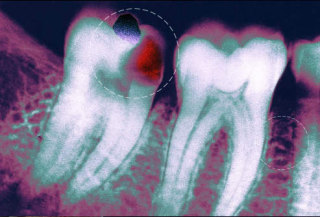
New Solution For Tooth Decay: Just Grow A New Tooth
T. Gooman
The main treatment for cavities - drill and fill - has given the dental profession a bad rep. Ask people what they hate to do most, and I bet half of them will say "Going to the dentist." But now, French researchers at the National Institute for Health and Medical Research in Paris have developed a painless and simple method that could very soon put an end to fillings. You know - Novocaine, water, air, drilling, sore mouth, and chemical taste?
Fillings are used to fill holes left by tooth decay. (Do yourself a favor and don't check out Google images for 'tooth decay.') Decay is caused by bacteria called streptococcus mutans, and yes it does feed on sugar in the diet. The French team, rather than identify other fillers for the holes, tried to find a way to make the tooth grow back to fill in the hole.

Cavity seen on an x-ray.: image via webMD.com
They made a gel substance from MSH (melanocyte-stimulating hormone) with poly-L-glutamic acid, a strong survivor often used to transport drugs through our bodies because it can fight off stomach acids that might destroy the medication. The researchers rubbed the gel on dental pulp fibroblasts taken from human tooth tissue and found that the gel triggered growth of new cells and adhered to each other.
MSH is a substance that is naturally produced by the pituitary gland and it is active in determining the lightness or darkness of our skin color. But recently, MSH has been identified as playing a crucial role in bone regeneration, which is what gave the researchers the idea to try it for tooth regeneration.
The researchers experimented with the gel on mice with dental cavities and the cavities disappeared within one month. It took the same amount of time to restore the human samples to form healthy new tooth tissue. Though it won't be available to dentists for 3 to 5 years, there's one thing you can count on: there won't be a hole in your tooth any more. That tissue you identify as "tooth" will come back and look just like your original - a brand new tooth.
Isn't science great?
The complete study is published by the American Chemical Society in its journal ACS Nano. Source: Daily Mail.
Medicine, Science, & Bio-Inspired Innovations
inventorspot.com/articles/new_solution_tooth_decay_just_grow_new_tooth
August 3, 2010
